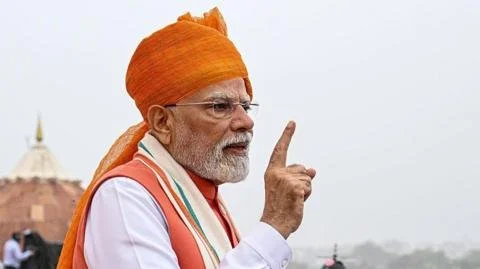Waves of Change: How Trump's Tariffs Spark Modi's Call for Economic Self-Reliance
Donald Trump’s harsh 50% tariffs on India have just gone into effect, triggering a wave of economic repercussions for the world’s fifth-largest economy. This decision follows an additional 25% penalty imposed by the US over India’s dealings with Russia, making India one of the nations facing the highest trade barriers worldwide. The impact on exports could be substantial, jeopardizing millions of jobs in export-driven sectors that cater to American consumers.
In response, Prime Minister Narendra Modi is racing to rescue the economy. Recently, he promised a significant tax cut aimed at alleviating the burden of these tariffs, while simultaneously advocating for self-reliance among Indian businesses. He emphasized this ‘self-reliance’ during public addresses, urging shopkeepers to display “Swadeshi” (or ‘Made in India’) signs to encourage local spending.
Modi’s economic strategy seeks to enlighten citizens not to despair but to take pride in self-sufficiency, despite global economic pressures. However, the manufacturing sector in India struggles, accounting for only 15% of GDP—indicating significant challenges to achieving self-reliance. The recent tax reforms aim to boost that figure by putting more disposable income into citizens’ hands, crucial for driving private consumption, which significantly contributes to GDP.
Experts are advocating for an overhaul of the Goods and Services Tax (GST), which has complicated regulatory processes. Modi’s administration is now proposing a streamlined two-tier GST system, expected to enhance compliance and encourage spending. Analysts highlight that this could lead to a $20 billion boost in consumption, countering the adverse effects of tariffs.
While rural spending is holding strong, urban demand has faced setbacks, particularly in sectors hit by the pandemic. The proposed tax cuts should catalyze economic recovery, with analysts believing they will push GDP growth and reduce inflation amidst global geopolitical tensions. Beneficiaries of these measures include consumer goods sectors like automobiles, apparel, and construction materials, crucial as demand typically surges around Diwali.
Moreover, these tax reforms could also pave the way for further interest rate reductions, encouraging borrowing and lending in the economy. Amidst this tumult, Indian stock markets have responded favorably, and the nation even received an unexpected sovereign credit rating upgrade—a positive signal for foreign investment.
However, despite proactive measures, India’s growth has plummeted from 8% in previous years, and tensions with the US over energy embargoes have escalated, with trade negotiations recently stalled. The hefty tariffs are considered akin to a trade sanction, marking a significant shift in relations between the US and India, previously thought to be strong allies. In this climate of uncertainty, Modi’s call for economic self-reliance and reform is more critical than ever.

